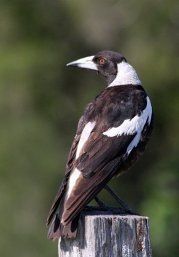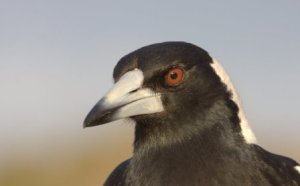Stay safe from swooping birds
Magpie swooping season
Time of year: Spring (August - November)
Why do they Swoop: As a territorial response to protect their eggs and young during their breeding season.

Things you can do
- Wear a broad-brimmed hat and sunglasses or shelter under an umbrella to protect your face from swooping magpies (painting or sticking large ‘eyes’ on the back of your hat can also deter magpies—but this won’t work for cyclists).
- If a magpie swoops while you are cycling, it will probably stop swooping if you get off your bike and walk.
- Avoid ‘defence zones’ during the breeding season by taking alternative routes that avoid entering the zone
- If you must enter a ‘defence zone’, magpies will be less likely to swoop if they are watched constantly, or if people walk in a close group.
- Use signs to warn other people of the location of nests and defence zones, particularly in areas used by children and the elderly.
- Wave or hold a stick or umbrella above your head.
- Cyclists can attach a brightly coloured flag to fly above their head or attach cable ties to their helmet, to discourage magpies from swooping.

Things you can do to be magpie friendly
- Don’t fight back if a magpie swoops. Throwing sticks and stones or yelling at a magpie may make it more aggressive next time someone enters the defence zone around their nest.
- Never approach a young magpie. Fledglings that have just left the nest or have fallen out are likely to be under the watchful eye of a parent. If you pick them up or get too close the parent bird may think you are a possible predator and become defensive in the future. If you believe they are at risk, wait until after dark before you pick them up and place them back in a tree.
Other birds that swoop
- Magpie-lark
- Laughing Kookaburra
- Red Wattlebird
- Grey Butcher bird
- Mockingbirds
- Swallows: Swallows use the swooping scare tactic to keep people, dogs, cats and other potential predators away from their nests.
Where you might encounter swooping birds
Birds that are territorial around nest sites usually limit their protective behaviour to a 100-200m radius around this location.
If you identify and avoid the nest location, you may avoid this behaviour by using the other side of the street in some cases.
Large birds like magpies nest in large trees, an in an urban environment they may also use power poles and streetlights as perches and alternate nest site.
Alternatively Smaller birds use dense scrubs as nest sites. And Masked Lapwings (Plovers), use open grassland as their camouflaged next site
Why do they swoop
Most birds swoop as a territorial response to protect their eggs and young during their breeding season. If you only notice birds when they swoop you may have missed the best aspects of birds being in your suburb.
If this swooping behaviour continues beyond the breeding season there may be other factors involved.